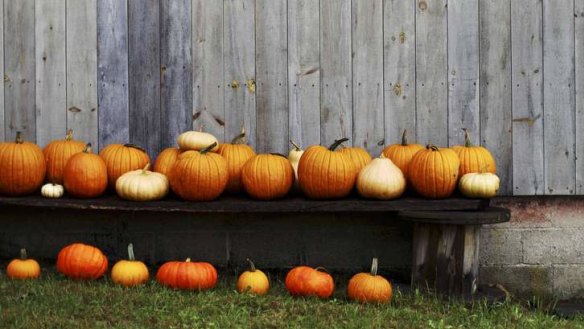Smashing pumpkins

Many of the crops you plant in spring have a long lead time until harvest, and it takes careful planning and preparation to get a good harvest despite the cold nights of early spring. Pumpkins fall into this category. Many require at least four months of hot weather to produce any crop at all.
This vegetable has been a mainstay for millennia, with the north American Indians relying on it to get them through winter.
Pumpkins grow best in a garden bed enriched with lots of compost. The roots can grow to more than a metre so having good deep soil with lots of organic matter mixed in will make a big difference. Many home gardeners have found that their best pumpkin crops have resulted from a seed germinating on the edge of their compost heaps. Healthy pumpkin vines can take up lots of space and the big leaves will cover all the ground. One solution in the backyard is to set up an inclined mesh support secured to the back fence.
Remember, on Australian averages, you will harvest just one or two pumpkins a vine, so if you want a good crop to get you through winter, you need to plant several vines. However, a reader in Nicholls reported that she harvested 12 Queensland blue pumpkins from one vine last season.
Make sure the pumpkins are growing in full sunshine. They need good drainage and regular watering, especially when flowering and the fruit is setting.
Pumpkins, just like zucchini, produce male and female flowers on each vine. Pollination is critical as the female flower will open early in the morning and within two days, the window for fertilisation is over. Bees are so important to pollinating every plant but especially pumpkins, so do everything you can to protect bees that visit - they are highly susceptible to poisonous chemicals. To help pollination, dedicated gardeners are out early in the morning with little paint brushes collecting pollen from the male flowers and transferring it to the female flowers.
Pumpkins grow best in a garden bed enriched with lots of compost.
The grey family of pumpkins do not have such thick skin and the flesh is bright orange and sweet tasting. This family will produce the best yields of all the larger pumpkins and the average weight of each can be six to seven kilograms. Jarrahdale is an excellent variety with thick sweet flesh. Queensland blue is also a large, full-flavoured pumpkin which will store well. Allow at least five months for the pumpkins to be fully ripe.
Butternut is the pear-shaped pumpkin producing two-kilogram fruit with a dense sweet tasting flesh. It can mature in four to five months. The Japanese kent pumpkins also have a thin skin and are very sweet but they can take six months to mature.
Golden nugget is a much smaller pumpkin that grows in just one square metre, with the bush looking more like a zucchini plant. You can get 10 to 15 round pumpkins on one plant. The flesh is not as thick as on the bigger varieties but you will get a crop in just three months.
Violina is a rare Italian pumpkin of the butternut type but much larger in size. It has a wrinkled tan-orange skin and deep orange flesh. It can be roasted, stuffed or baked.
Musque de Provence is a flatter pumpkin, ribbed and with a tan-coloured skin and deep orange flesh. The pumpkins will grow to four to six kilograms. This is a good pumpkin for winter storage but it can take five or six months to grow.
My other favourite is the cinderella pumpkin (rouge vif d'etampes) with its bright orange skin in the shape of a Dutch cheese wheel. It produces a very smooth pumpkin soup.
I really enjoy pumpkin soup with lots of grated fresh garlic and some added potato. Cooking pumpkin with herbs such as sage, coriander, rosemary or thyme is delicious. Baked pumpkin just rounds off a roast dinner for me. And pumpkin seeds can be dried, then roasted with a little olive oil and salt until golden brown.
This week I'm:
■ Plant basil, coriander and oregano seeds into your herb garden. They grow well in long containers, too.
■ Plant your first rows of sweetcorn beside rows of bush beans to provide additional nitrogen for the heavy-feeding corn crop.
■ For early summer crops, plant a row of open lettuces, silverbeet and beetroot.
■ Plant a mix of carrot and radish seeds into a well-dug, deep-soil section of the garden. The radishes will sprout quickly and help break the surface soil for the carrots. Keep the surface of the garden bed moist until the carrots appear.
■ Transplant early tomato seedlings into small or middle-size pots to grow them on but still provide good protection from cold nights. Plant the stems deep in the potting mix because the buried stems can produce additional roots to strengthen the plant.
■ Build up the soil around your asparagus plants when the spears begin to emerge. This will keep the shoots white and tender.
■ Begin thinning stone-fruit trees if your fruit set is very heavy. Early thinning allows the trees to direct their energy to the remaining fruit to produce premium-size fruit.
>> Owen Pidgeon owns the Loriendale Organic Orchard near Hall.
Restaurant reviews, news and the hottest openings served to your inbox.
Sign up